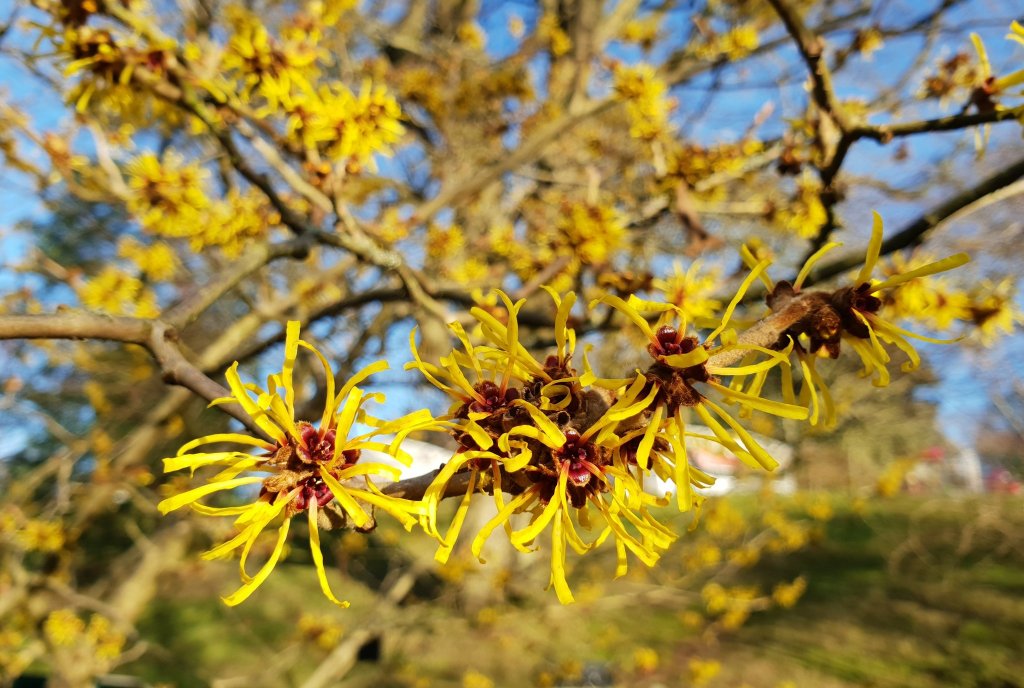Once again we are being told to stay at home, though hopefully this time for a shorter period. The big difference between this lockdown and the last is we are heading into winter. The benefits to both our physical and mental health from sunlight and fresh air are well documented, so the prospect of lower light levels and shorter days can seem gloomy. Making the most of the daylight we do have now is essential and spending just an hour or two outside, for exercise, can boost our health and open our eyes to a very different kind of winter wonderland.

The winter sun, lower in the sky, creates magical silhouettes and illuminates leaves, old flower stems and seedheads. As trees move gently with the breeze, sunlight flashes and flickers and shadows will shift, revealing different highlights and focal points. A camera or phone memory card can quickly be filled by such ample photographic opportunity.

At no other time of year is the air filled with such a variety of sweet and powerful fragrances, attracting the few remaining pollinators. Citrusy and spicy witch hazels are joined by rose scented daphnes, Christmas box, vanilla scented viburnums, wintersweet and even honeysuckles.
Yes, winter honeysuckle really is a thing and the scent is a delight. Lonicera fragrantissima is one of the most well known winter honeysuckles. The flowers are smaller than its summer flowering cousin and can sometimes be missed by the eye but the nose will certainly find it.

(nepalese paperbark).
Fragrant winter flowering shrubs are enjoyed even before autumn is over and many flower until spring but mid January is when the earlier and later flowering plants overlap, creating an assault on the senses. Daphne bholua ‘Darjeeling’ flowers throughout December and into January. As its blooms fade, Daphne bholua ‘Jacqueline Postill’ takes over, flowering for a good six weeks. Daphne is a wonderful genus with different species in flower every month of the year.

Often called the harbingers of spring, Galanthus (snowdrops) have a much longer season than many would think. The earliest, such as some cultivars of Galanthus reginae- olgae, flower in autumn. Different species flower in succession throughout winter and into spring.

From autumn through to spring, cyclamen are some of the hardest working plants. There are 23 species of cyclamen, though most people only know the ‘florist’ type which are usually found adorning supermarket shelves in garish colours at this time of year. These florist cyclamen however are not hardy as they are bred from the tender Cyclamen persicum. There are two main, easy to grow species for the garden.
Cyclamen hederifolium flower from autumn to early winter. Flowers are followed by intricately patterned ivy like foliage. Cyclamen coum will show their leaves from autumn followed by drifts of flowers from December, right up to March. Once Cyclamen flowers are pollinated the peduncle (stem) will coil to the ground where the seeds will wait to be distributed by ants in summer. The ants are tempted by the seeds sugary coating. The seeds will not germinate until the ants have eaten the sugar. Remarkably clever. Learn more about cyclamen from the Cyclamen Society website https://www.cyclamen.org/

‘Ashwood Garden Hybrids’
(lenten rose)
Hellebores are probably the showiest plants of winter. Large flowers, in an array of colours, nod their heads in order to protect their reproductive organs from the elements. Hellebores do not have petals but brightly coloured sepals. The petals have evolved into nectaries and early pollinators can be seen foraging from these on mild winter days. John Massey and his team at Ashwood Nurseries have been developing and improving this genus for decades. Hellebore tours at Ashwood usually take place in late winter. See updates on their website for 2021 https://www.ashwoodnurseries.com/events/categories/hellebore-tours/
I’m very fortunate to work in a botanical garden, so I get to work amongst these wonderful plants every day. Membership to most public gardens is very reasonable, so well worth buying either for yourself or as a gift in the run up to Christmas. If you don’t have a garden or access to a public garden, take a look in front gardens, parks or even roadside plantings. Follow your nose and you might be surprised.
Really enjoyed reading this pieece, Chris. Don’t do yourself down as ‘no writer’ – it reads well and it’s lifted my spirits on a Monday morning with the prospect of at least 1month’s lockdown ahead. We don’t have a Daphne in the garden – clearly a serious shortcoming which we must address as a priority!
LikeLiked by 1 person
Really well written, and accompanied by the usual fantastic photography, mate. So satisfying getting to see you indulge your passion through your work in a job that was made for you. Thanks for sharing. A welcome respite from the madness. Stay safe and well Chris. Keep it coming!
LikeLiked by 1 person
Thanks Matt. Hope you’re all keeping well. Look forward to a catch up when all of this is over.
LikeLike
Very late to the party (as usual) but couldn’t agree more! Great article, v well written. Els
LikeLike
Thanks, that’s very kind.
LikeLike
I iI loveI loved reading it! So inspiring. Cant wait for the next post. Thank you very much!
LikeLiked by 1 person
Inspiring Thank you Chris . Also winter light for great photo Opps
LikeLiked by 1 person
Fantastic writing and amazing photos
LikeLiked by 1 person
Thank you Nikki
LikeLike
another bit of beautiful writing, Chris. So evocative of the Winter season at it’s best along with encouragement to action. Stunning pictures of the Birmingham Botanical Gardens showing what people are missing by thinking that there’s nothing to see at this time of year. How wrong can they be!
LikeLiked by 1 person
What a great read, Chris, and your photos are always superb!
LikeLike
Thanks Darren
LikeLike